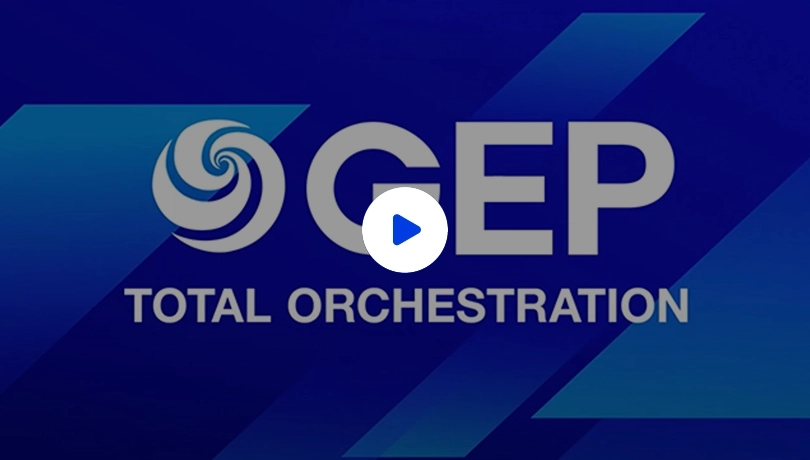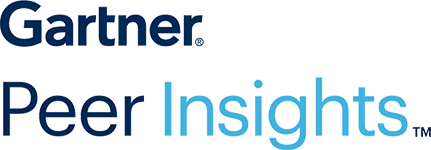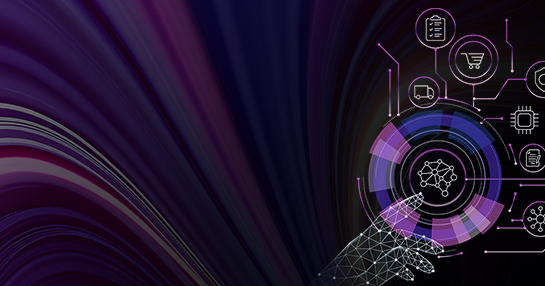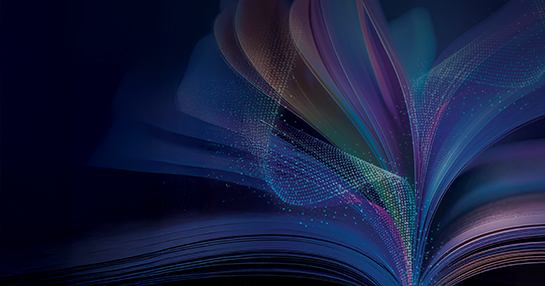Procurement is undergoing a seismic shift, calling for revolutionary solutions to harmonize operations, elevate the user experience and enable smarter, faster decisions. Our AI-driven orchestration platform — powered by GEP QUANTUM — redefines the procurement landscape. Designed to provide enterprises with intuitive, seamless and self-service capabilities, it delivers exceptional efficiency, cost savings and compliance while enabling end-to-end visibility across the source-to-pay process.
Simplify Procurement with Smart Workflows & Exceptional User Experience
Intake Management
Seamless User Experience: One AI-enhanced interface for all users simplifies requisitions from start to finish, ensuring quick and effective management with total visibility.
Save Smartly on What You Buy: Spend wisely and save, as your money goes to the right places.
Smart Orchestration
Synchronized Procurement Functions: From intake to payment, our platform reduces complexities and errors, making every process smoother and faster.
Intelligent Workflow Integration: Connect all data seamlessly and automate your workflows using advanced intelligence, enabling your team to achieve goals efficiently, regardless of geographical barriers.
Effortless Integration
AI-Driven Platform: Connect all your procurement processes seamlessly with GEP Quantum.
Plug & Play: Instant compatibility with existing systems ensures no downtime, just uptime.
Visibility & Control
Dashboards & Insights: Gain comprehensive insights into your procurement activities with real-time, customizable dashboards.
Decisions at a Glance: Empower your team to make quick, informed decisions with AI-driven analytics.
GEP's Total Orchestration Engine: Driving Supply Chain's Next Era
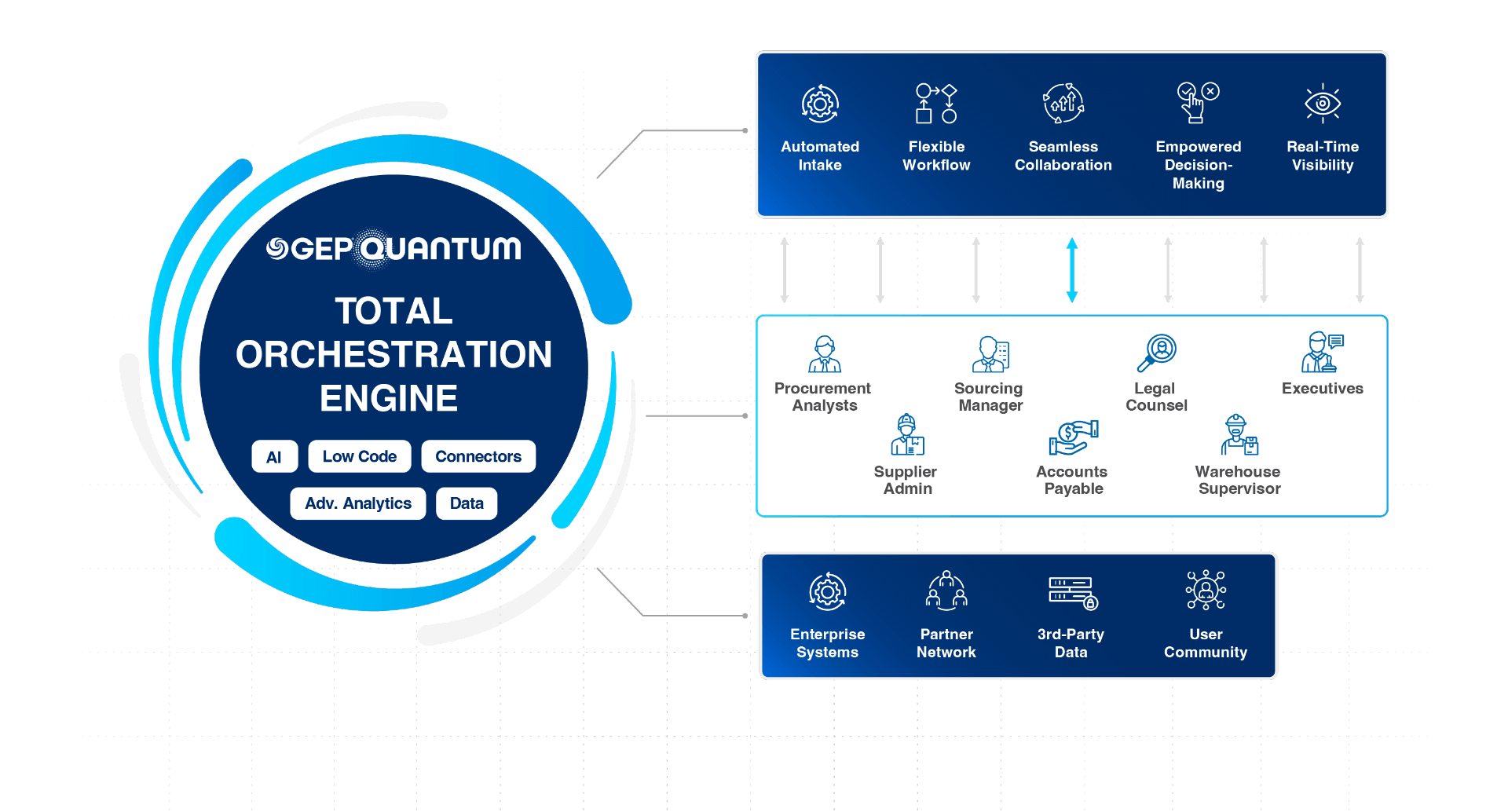
FAQs
Procurement orchestration refers to the end-to-end process and workflow orchestration in procurement, regardless of whether it is initiated from a user request. It is a complete approach to streamlining and optimizing the entire procurement process — from sourcing to supplier management to payment processing, and more.
With the use of new technologies, especially Gen-AI — as well as cloud-based platforms, artificial intelligence (AI), and robotic process automation (RPA) — procurement orchestration has enabled real-time data analysis, automated workflows, and intelligent decision-making in the procurement process. All of these can help enterprises speed up efforts and minimize errors.
Look at it as a top layer over all the procurement technology to seamlessly facilitate collaboration among various stakeholders, including procurement teams, suppliers, and internal business units.
Procurement orchestration has clearly defined objectives to strategically optimize internal customer/user experience (like in the indirect buying process), and to boost cost savings for the enterprise.
Procurement orchestration also aims to eliminate silos and break down barriers within the procurement organization. Conventional procurement processes have so far been observed to operate in silos — leading to collaboration inefficiencies and communication gaps — ultimately resulting in higher costs. Procurement orchestration integrates and coordinates all procurement activities into a streamlined process and drives efficiencies on multiple fronts.
However — optimizing user experience is getting increasingly important because more and more procurement activities are conducted by users outside of procurement. And they often are frustrated and lost in the process. Providing them with process guidance, decision support and progress transparency is therefore becoming increasingly important.
Procurement orchestration also aims to enhance supplier management and collaboration. Transparent and effective supplier communication helps enterprises negotiate better terms, leverage volume discounts, and optimize their operational relationships with suppliers. A strategic approach to supplier management not only drives cost savings, but also mitigates risks and nurtures innovation within the supply chain ecosystem.
Procurement orchestration can transform procurement operations and drive strategic value for an enterprise. Let’s take a look at some of the key benefits of implementing procurement orchestration:
Driving Strategic Value
Procurement orchestration has the potential to elevate procurement to a more strategic role within an organization, better positioning it for the future. Instead of focusing on cost-cutting alone, an orchestrated procurement function can act as a value orchestrator across the enterprise. Furthermore, combining orchestration with effective intake management can greatly improve the enterprise user experience with procurement processes and boost overall efficiency. Orchestration can also enable and enhance new strategic initiatives for the business, such as those related to ESG factors.
Improved Compliance and Risk Mitigation
Procurement orchestration streamlines tasks such as supplier onboarding, contract management, and spend analysis, ensuring compliance with policies and regulations. Consistent adherence to internal policies, industry regulations, and legal requirements helps enterprises mitigate the risks associated with non-compliance.
Procurement orchestration also facilitates better supplier risk management, enabling enterprises to proactively identify and address potential risks.
Agile and Scalable
Real-time visibility into procurement activities and supplier performance allows enterprises to keep their strategies agile, thereby giving them the ability to mitigate potential risks and seize potential opportunities. Furthermore, procurement orchestration platforms are designed to be scalable, enabling enterprises to seamlessly adapt to evolving business needs.
Implementing a procurement orchestration strategy brings numerous benefits, but there are several challenges that have to be addressed effectively. Here are some common challenges associated with procurement orchestration:
Data Integration
Bringing together data from disparate sources and seamlessly integrating various procurement systems, ERPs, and third-party applications can be a significant challenge and also a step toward procurement orchestration.
Process Automation and Visibility
Another challenge in procurement orchestration is implementing technology solutions that can streamline and automate procurement workflows while providing real-time visibility into processes and performance metrics across the entire source-to-pay (S2P) cycle.
User Experience Alignment
Aligning the gap between user needs and backend processes is necessary to deliver an excellent user experience at the frontend while ensuring transparency and efficiency.
Workflow Adaptation
Enabling the ability to modify and adapt procurement workflows and processes within the system without heavy reliance on IT resources is a significant challenge, but it can be achieved through low-code/no-code capabilities.
Level of Digitization
Enterprises need to assess their current state of digitization and develop a roadmap to implement digital technologies because achieving the right level of digitization is crucial for enabling procurement orchestration.
Ecosystem Connectivity
Establishing seamless connectivity and data exchange with diverse systems, including external partners and the larger supply chain ecosystem, can be a serious technical and operational challenge due to varying protocols and requirements.
Change Management and Culture Shift
Enterprises need to drive the necessary change management initiatives to transition from an inward-focused mindset to a customer-centric, value-driven procurement culture, and develop the required talent and skillset.
The key technology considerations for procurement orchestration include:
- Embedded AI (and specifically GenAI) to provide consistent and organic capability to what users exactly need to accomplish their goal
- Strong and easy integration to connect to other systems (such as ERP), data sources, etc. so that partners can quickly get all data into one place — data lake
- Good master data management for synchronization — so that there can be a single source of truth
- The ability to configure, modify, and create workflows on the fly, without heavy dependency on IT (in short, low code)
- Excellent user interface to manage user experience (AI and UX), intake management
- E2E and unified functionality in S2P. If the provider uses API to connect with other S2P functions without having them on the platform, it cannot achieve true orchestration.
- Adoptive and futureproof
Ultimately, it is not about technology — it is about business. The technology therefore should fundamentally build three capability elements: real-time visibility, seamless collaboration, and intelligent insights.
Procurement orchestration is changing the way procurement operates. Its evolution is therefore expected to be shaped by the potential emerging and future trends, some of which are as follows:
- Artificial intelligence (AI)
- Increasing focus on user experience and support of user decision making (and not just automation or manual; it is a collaboration)
- Supplier collaboration network
- Centralized data management
- Balance between cost, risk, sustainability, and innovation — ensuring multi-dimensional aspect is managed
These procurement trends highlight the continued evolution of procurement orchestration — driven by technological advancements, data-driven insights, and the need for greater efficiency, transparency, and sustainability in procurement processes.












